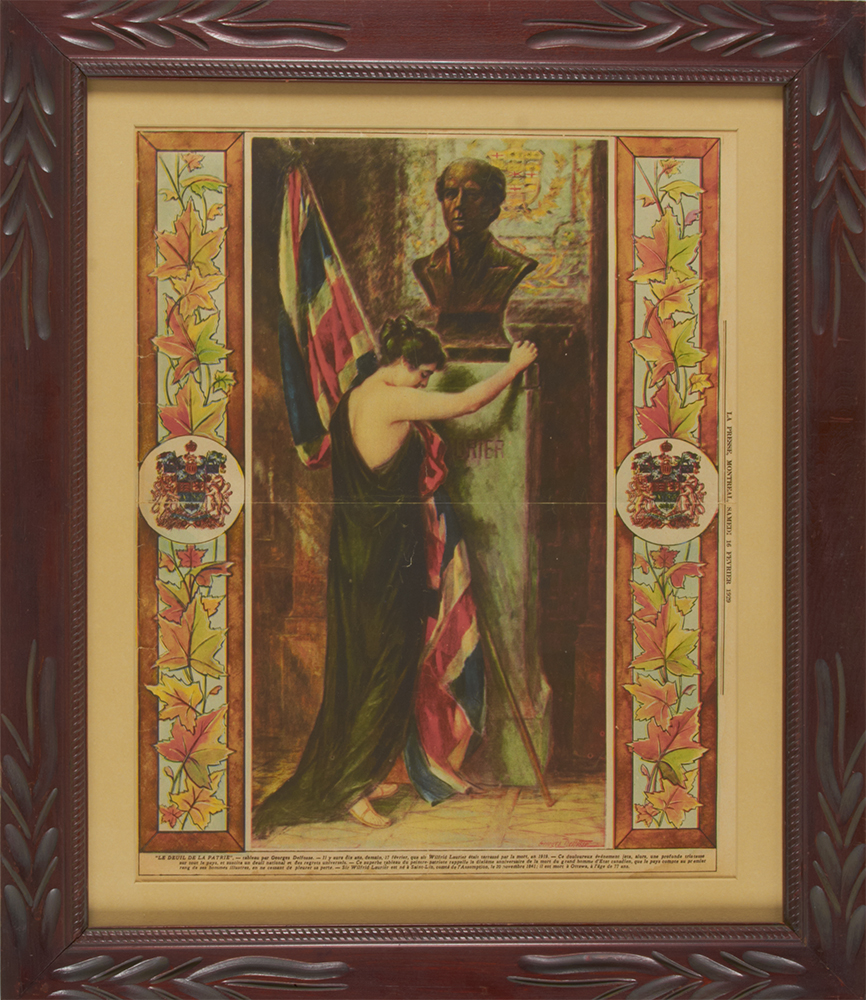A visual testament to Wilfrid Laurier’s enduring “cult”
December 21, 2016
A young woman stands despondently before a bust of Prime Minister Wilfrid Laurier. Between the two figures are assorted symbols of Canada, still a young nation, while the women’s stance — embracing the monument, head hanging low — simultaneously speaks of affection and sorrow.
One day in 1929, readers of La Presse were greeted by this full-colour image, a high quality rotogravure reproduction of Montréal artist Georges Delfosse’s work Le Deuil de la Patrie, suitable for framing. Given Laurier’s immense popularity in Quebec, it’s likely this commemorative page made its way onto the walls of many La Presse readers.
Contained in a nearly 1,000-piece collection of political memorabilia donated to the Canadian Museum of History by Senator Serge Joyal in 2015, the Delfosse illustration makes a powerful statement about Laurier’s enduring influence, particularly in French Canada.
Affection didn’t fade
“There was a reverence for Laurier that lasted well beyond his time in office,” says political history curator Xavier Gélinas. “A solid block of French Canadians believed that Laurier had overturned the Conquest. More than a hundred years after the Plains of Abraham, with Laurier as Prime Minister, it seemed that they were finally considered equals of English-speaking Canadians.”
It’s unsurprising that La Presse would use Delfosse’s illustration to mark the death of Canada’s first French-speaking Prime Minister. What is surprising, however, is that it was published 10 years after Laurier’s death in 1919. Gélinas says this is evidence of a “cult of Laurier” that persisted well into the 1930s, fed by the memory of his charm and good looks, and an optimistic oratorical style that convinced both English- and French-speaking Canadians to accept his positive, forward-looking vision of the country.
Even now, the Laurier “cult” lingers. When current Prime Minister Justin Trudeau assumed office, he evoked Laurier’s famous espousal of “sunny ways.” Laurier still stands for something that transcends his political record.
Laurier’s vision of Canada has had “a continuous impact on our national political consciousness,” adds Senator Serge Joyal, who donated the artifact as part of this rich collection. “Even today, images of Laurier are still printed on T-shirts and badges. Laurier continues to incarnate the vision of an ideal Canada, as vivid today as it was in his time.”
An indefinable “something extra”
Quebecers reading La Presse in 1929 likely longed for the age of Laurier in much the same way a later generation of Americans sought to recapture John F. Kennedy’s mythic age of “Camelot.” Although the 1920s brought prosperity to Canada, leaders like Robert Borden and William Lyon Mackenzie King were not imbued with Laurier’s inspirational, visionary quality.
Scarred by the First World War, they also likely had “a nostalgia or a melancholy for the year 1900, when one could hear ‘the 20th century belongs to Canada’ and boatloads of people were arriving to build something new, something fresh. It’s like adolescence,” Gélinas reflects. “When its gone, its gone.”
“Laurier was a figure not unlike Che Guevara or Martin Luther King or John F. Kennedy,” Gélinas elaborates. “His actual accomplishments are respectable, but they almost count for very little in the cult. He was one of those people who have a little extra. Some people have the magic touch and some people don’t. Laurier certainly had it.”
Image:
Le Deuil de la Patrie (The Motherland Mourns)
Rare poster commemorating the anniversary of the death of Sir Wilfred Laurier
Coloured paper
Reproduction of a painting by Georges Delfosse, published in the newspaper La Presse on February 16, 1929
56.5 x 45 cm
Serge Joyal Collection, IMG2014-0141-0008-Dm